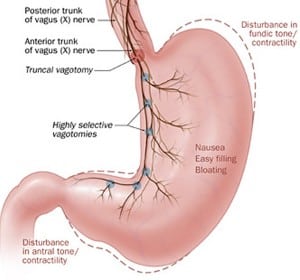Gastroparesis occurs when food and fluids move too slowly out of the stomach into the duodenum due to damaged nerves or muscles. For many people, gastroparesis is a lifelong condition. But treatment can help relieve symptoms and prevent complications.
In healthy individuals, signals from nerves tell the stomach muscles when to contract. These muscles move food from the stomach into the duodenum (first part of the small bowel). With gastroparesis, the nerves or muscles are damaged. This causes motility to slow down or stop completely. As a result, food cannot move from the stomach properly. This delayed emptying can cause nausea, vomiting and other symptoms. Malnutrition can result. Bezoars (hardened lumps of food) can form in the stomach and cause other complications as well.
Causes of Gastroparesis
- Diabetes
- Surgery involving any of the digestive organs, such as the stomach and bowels.
- Certain medications, such as strong pain medications.
- Certain conditions, such as systemic scleroderma, Parkinson’s disease and thyroid disease.
- In many cases, the cause of Gastroparesis cannot be found.
Signs and Symptoms of Gastroparesis
- Nausea and vomiting
- Feeling full quickly when eating
- Abdominal pain
- Heartburn
- Weight loss
- Loss of appetite
- High and low blood sugar levels (in diabetes patients)
Diagnosing Gastroparesis
In addition to a health exam, blood tests and X-‐ray, the following tests can be used for evaluating gastroparesis.
- Upper endoscopy
- Upper gastrointestinal (GI) series
- Gastric emptying scan to measure how quickly food leaves the stomach. For the test, a meal containing a harmless radioactive substance (tracer) is eaten. Then scans of the stomach are done. The tracer shows up clearly on the scans and shows the movement of the food through the stomach.
- Gastroduodenal manometry to measure the pressure changes that occur as the muscles in the stomach and small bowel contract during digestion. For the test, a thin tube is inserted through the nose and guided down into the stomach and small bowel. The tube is connected to a computer that collects and records the data.
- Wireless capsule device, a harmless device shaped like a pill that is swallowed to collect information about the GI tract. As the capsule travels through the GI tract, data is sent to a receiver worn on a necklace or belt.
Treating Gastroparesis
The goal of treatment is to help you manage your condition. Treatment may include one or more of the following:
- Dietary changes, such as eating smaller throughout the day. Or, you may be placed on a liquid or “soft” diet. You may need to avoid foods high in fats and fiber that slow digestion. In severe cases, you may need a feeding tube that sends liquid food or medication directly to your small bowel.
- Medications can help manage symptoms, such as nausea and vomiting. They can also improve motility. Each medication has specific risks and side effects.
- Surgery may be needed to place a tube into the stomach for removing excess air and fluid. This can relieve severe symptoms of nausea and vomiting. In rare cases, other surgery may be needed on the stomach or small bowel. This is to create a new passageway for food to be emptied from the stomach.
- Other treatments can include botulin toxin and gastric electrical stimulation.
If you have diabetes, gastroparesis can make it harder to manager your blood sugar level. You will need to take extra steps to prevent complication. Talk with your doctor.

